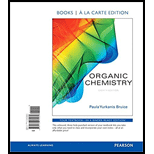
Concept explainers
(a)
Interpretation:
Movement of electrons should be indicated using curved arrows for the given reaction.
Concept introduction:
Mechanism of the reaction is the step-by-step description of the process by which reactants are changed into products.
Curved arrows show the bonds that are formed and the bonds that are broken in a reaction.
Curved arrows used to understand a reaction mechanism.
Curved arrows are drawn to show how the electrons move as new covalent bonds are formed existing covalent bonds are broken.
Each arrow represents the simultaneous movement of two electrons from a nucleophile towards an electrophile.
The tail of the arrow is positioned where the electrons are in the reactant; the tail always start at a lone pair of electron or at a bond.
The head of the arrow points to where these same electrons end up in the product; the arrow always points at an atom or a bond.
(b)
Interpretation:
Movement of electrons should be indicated using curved arrows for the given reaction.
Concept introduction:
Mechanism of the reaction is the step-by-step description of the process by which reactants are changed into products.
Curved arrows show the bonds that are formed and the bonds that are broken in a reaction.
Curved arrows used to understand a reaction mechanism.
Curved arrows are drawn to show how the electrons move as new covalent bonds are formed existing covalent bonds are broken.
Each arrow represents the simultaneous movement of two electrons from a nucleophile towards an electrophile.
The tail of the arrow is positioned where the electrons are in the reactant; the tail always starts at a lone pair of electron or at a bond.
The head of the arrow points to where these same electrons end up in the product; the arrow always points at an atom or a bond.
(c)
Interpretation:
Movement of electrons should be indicated using curved arrows for the given reaction.
Concept introduction:
Mechanism of the reaction is the step-by-step description of the process by which reactants are changed into products.
Curved arrows show the bonds that are formed and the bonds that are broken in a reaction.
Curved arrows used to understand a reaction mechanism.
Curved arrows are drawn to show how the electrons move as new covalent bonds are formed existing covalent bonds are broken.
Each arrow represents the simultaneous movement of two electrons from a nucleophile towards an electrophile.
The tail of the arrow is positioned where the electrons are in the reactant; the tail always starts at a lone pair of electron or at a bond.
The head of the arrow points to where these same electrons end up in the product; the arrow always points at an atom or a bond.
(d)
Interpretation:
Movement of electrons should be indicated using curved arrows for the given reaction.
Concept introduction:
Mechanism of the reaction is the step-by-step description of the process by which reactants are changed into products.
Curved arrows show the bonds that are formed and the bonds that are broken in a reaction.
Curved arrows used to understand a reaction mechanism.
Curved arrows are drawn to show how the electrons move as new covalent bonds are formed existing covalent bonds are broken.
Each arrow represents the simultaneous movement of two electrons from a nucleophile towards an electrophile.
The tail of the arrow is positioned where the electrons are in the reactant; the tail always starts at a lone pair of electron or at a bond.
The head of the arrow points to where these same electrons end up in the product; the arrow always points at an atom or a bond.
(e)
Interpretation:
Movement of electrons should be indicated using curved arrows for the given reaction.
Concept introduction:
Mechanism of the reaction is the step-by-step description of the process by which reactants are changed into products.
Curved arrows show the bonds that are formed and the bonds that are broken in a reaction.
Curved arrows used to understand a reaction mechanism.
Curved arrows are drawn to show how the electrons move as new covalent bonds are formed existing covalent bonds are broken.
Each arrow represents the simultaneous movement of two electrons from a nucleophile towards an electrophile.
The tail of the arrow is positioned where the electrons are in the reactant; the tail always starts at a lone pair of electron or at a bond.
The head of the arrow points to where these same electrons end up in the product; the arrow always points at an atom or a bond.
Want to see the full answer?
Check out a sample textbook solution
Chapter 5 Solutions
ORGANIC CHEMISTRY (LL)-W/MOD.MASTERING.
- from the list of reagents select those that carry out the transformation above the list.please make sure the corrosponding letters are in the correct order for the reaction starting on the left.i.e. cd = 1. LiAlH4 then H3O+, 2. H2, Pd/Carrow_forwardDraw mechanisms for the following reactions. Use curved arrows to show electron flow for each step and draw out all reactants to effectively show all arrow pushing. Write a written description of the mechanisms.arrow_forwardThe use of curved arrows is a powerful tool that illustrates even complex reactions. a.Add curved arrows to show how carbocation A is converted to carbocation B. Label each new σ bond formed. Similar reactions have been used in elegant syntheses of steroids. b.Draw the product by following the curved arrows. This reaction is an example of a [3,3] sigmatropic rearrangement, as we will learn in Chapter 25.arrow_forward
- Show how the products are formed, drawing curved arrows to show electron reorganization.arrow_forwardRank the following groups in order of decreasing priority. −COOH, −CH2OH, −H, −CHOarrow_forwardFinish ONE of the indicated reactions by filling in any starting materials, reagents, or products as needed.arrow_forward
 Organic Chemistry: A Guided InquiryChemistryISBN:9780618974122Author:Andrei StraumanisPublisher:Cengage Learning
Organic Chemistry: A Guided InquiryChemistryISBN:9780618974122Author:Andrei StraumanisPublisher:Cengage Learning Organic ChemistryChemistryISBN:9781305580350Author:William H. Brown, Brent L. Iverson, Eric Anslyn, Christopher S. FootePublisher:Cengage Learning
Organic ChemistryChemistryISBN:9781305580350Author:William H. Brown, Brent L. Iverson, Eric Anslyn, Christopher S. FootePublisher:Cengage Learning


